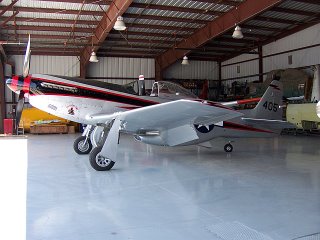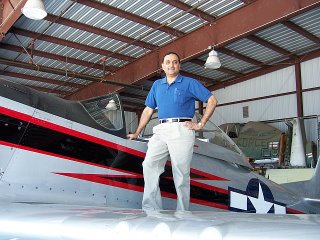I am still due to write about the T-28 flight but I’ll do that after my little side trip to Reno, Nevada in a B200 turboprop this weekend, followed by a Hawker 400XP executive jet day trip all the way across the US and back the same day on Monday. I still have a lot to blog about my trips to three different cities scattered across the US in the preceding four days and two of these cities have aviation historical background that I found interesting. That’s coming up next.
 The P51D Mustang sitting in Chuck's hangar at Camarillo
The P51D Mustang sitting in Chuck's hangar at CamarilloMeanwhile, there are very few flying P51 Mustangs in the World and two of the best pieces happen to be here in Camarillo, California, where yours truly has landed up, exhausted, after all the other trips. How fun is that! To have one P51 sold to a guy in Sweden by Chuck Smith of C&J Aircraft sales (I had written about him and what he does, in my T-28 Trojan article) and that airplane parked in Chuck’s hangar for us to see, up close, real close!
Vidya had written in a comment on my article “out of Scotland” that my trip read more like the legendary fictional World War II fighter pilot called Biggles and there were a series of books on him. I guess Biggles flew the Spitfire alongside the allies the Americans flying the P51 Mustangs. The engines used were the Rolls Royce - Packard Merlin, so the Brits can claim proudly that their engine had good success on the American airframe. This Airplane out flew everything the Germans and the Italians and whoever were a part of the Axis powers had, in fact they destroyed 4,950 enemy Aircraft over Europe during the War. The 12-Cylinder Vee engines developed 1695 HP and the Aircraft top speed was 437 Miles per hour! That’s fast, by the way.
It’s a treat to be around such vintage Aircraft. These are the same airplanes that we, as kids read about in those commando comics borrowed from the neighborhood library for 25 Paisa per day, I think, and fantasized about flying those machines. If I had been stuck in one place in India, I’d never have had this opportunity but luckily I have been fortunate to be able to roam around the World and be able to see, feel and maybe even fly those magnificent flying machines.
Lots more coming up …

9 comments:
Hi sir ,
had seen such models in books and movies and never knew its significance in the war ,
intresting to know those here ,,
may b in those times the pilots must have had a tough time fighting and flying cos those planes weren that advanced as that of now ...
Yes, Athul, but the P51, for its time, was very modern and well equipped. The sound of its merlin engine, even today, is so sweet, it is music to my ears! Tough times they were, for those pilots having to outfox Me-109 fighters that Germany had and those were real good flying machines as well. We al know how pointless wars really are but for us humans, it is inevitable till we reach a higher level of evolution. However, wars have directly affected the way Aircraft have been designed and produced and many WW II Aircraft found new life after the war, as Airliners. the venerable DC-3 Dakota being one of them. They used to churn out these airplanes as fast as they could during the War and after that the surplus airplanes found new homes in civil aviation.
Hi Anup (I think I will start to call you that after Vijayendra's advice - leaving out the Captain).
It is good to have an aviation historian among us. Keep churning out the stuff. That will keep us non fliers in the sky.
Great going.
Madhukar and Vijendra, thanks and I will keep up the history going. For some, history is boring because nobody likes to remember dates! But, I shall endeavor to make the historical aspect interesting, with realted stories, anecdotes and pictures. Hows that? For me, I'd want to take part in history, if I can just re-create some of the historical achievements in aviation. When i say recreate, I mean using historical aircraft, flying historical routes and perhaps document the entire project. More about this later.
Yes, Vidya the original spirit of st. louis is at the National Air and Space museum. The Flyer 1 is a model of the original, if I am not wrong. The Air and Space Museum of the Smithsonian Institute in Washington D.C. is like Mecca to us aviators. I have not been there in ten years now and need to pay a visit again soon. I guess you would have seen new exhibits, if any? My first visit was 18 years back!
"..I wish I had had an aviation expert like you along when I visited the National Air and Space museum at Washington DC last year.."
So is my wish too..Also at the air museum in Dayton, Ohio. These days there are some audio tour gadgets available at the museums and they do a pretty good job but there's no substitute to a pilot who has some of his own stories to tell.
Yes, Vidya, when your little one is older, there's going to be more curuosity and assimilation of whats at the museum.
Anonymous, Dayton Air Force museum is also interesting, matter of fact, I wuz there last week. will be a pleasure to introduce aircraft and talk about aviation anywhere. For me, its not only bread and butter but a passion always. Thanks for your comments anonymous.
Biggles was a fictional WW 1 fighter pilot not WW11. His exploits made interesting reading when we were kids.
Anonymous, you are right indeed. Biggles was mostly a WW1 pilot. There are some books even post WW2 that has him flying non combat, according to wikipedia. Thanks for your comment and correction.
Post a Comment